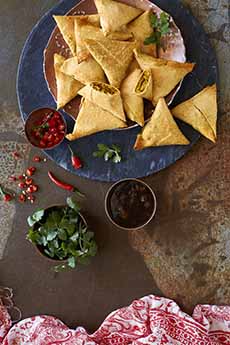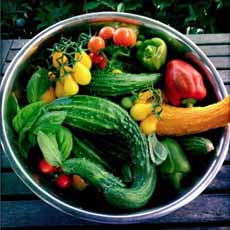|
This delicious, nutritious smoothie is from Kelly at SuperHealthyKids.com.
“I love using frozen organic fruit,” says Kelly, “because it’s frozen at its peak freshness. It’s available year-round, is generally less expensive than fresh organic fruit, especially when out of season. And it’s great in smoothies!”
The smoothie is made with three separate layers (photo #1), but if you don’t want to create patriotic artistry, just blend all of the ingredients together for a fruit fest.
You can also freeze it for an hour or so and serve as a sorbet.
The layers:
Red: frozen strawberries, raspberry juice or any red juice, honey.
White: fresh bananas, unsweetened vanilla almond milk (or any milk), ice cubes.
Blue: frozen blueberries, unsweetened vanilla almond milk or substitute, ground flax seeds.
The smoothie is as healthy as it is patriotic, packed with vitamin K from the berries, potassium and vitamin B6 from the bananas, and fiber and omega-3s from the flax.
RECIPE: RED, WHITE & BLUE SMOOTHIE
Ingredients For 4 Smoothies, 8-12 Ounces
For The Blue Layer
2 cups blueberries
1-1/4 cups unsweetened vanilla almond milk
2 tablespoons ground flaxseed
For The White Layer
2 medium bananas
1 cup unsweetened almond milk
For The Red Layer
2 cups whole strawberries, frozen
1 cup raspberry juice
1 tablespoon honey
Optional Garnishes
A pick with fresh or thawed berries
Watermelon stars (photo #3) for “stars and stripes”
Preparation
1. BLEND the blue layer ingredients together. Pour it into individual glasses, about 1/3 full. Place the glasses in the freezer for 10 minutes.
2. RINSE the blender jar to remove any remaining blue layer mixture. Then create the white layer: Add the ingredients and blend until smooth. Pour the white layer over the frozen red layer, filling the glass to 2/3 full. Place the glasses back in freezer for 15 minutes.
|
|

[1] A patriotic smoothie. For days when you don’t want stripes, you can simply toss all the ingredients into the blender at once (photo courtesy Super Healthy Kids). Note that instead of the layers as shown, we reversed the blue and red layers so that they read red, white and blue from top to bottom.

[2] Bananas create the white layer (photo courtesy Recipes.com).

[3] Whatever you drink, make this snazzy garnish. Here’s how from Domestic Fits.
|













